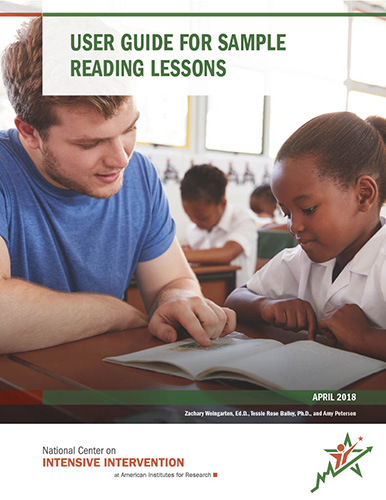Literacy Sample Lessons to Support Intensifying Intervention
Literacy Sample Lessons to Support Intensifying Intervention
NCII provides a series of reading lessons to support special education instructors, reading interventionists, and others working with students who struggle with reading. These lessons, adapted with permission from the Florida Center for Reading Research and Meadows Center for Preventing Educational Risk, address key reading and prereading skills and incorporate research-based instructional principles that can help intensify and individualize reading instruction. The reading lessons are examples of brief instructional routines that may be used to supplement reading interventions, programs, or curricula that are currently in place. These lessons are designed to illustrate concepts and supplement, not supplant, reading instruction and interventions for struggling readers. They do not represent an exhaustive reading curriculum. It is expected that teachers would customize these lessons to meet the needs of their target students.
The NCII reading lessons are organized around the five components of reading identified by the National Reading Panel (2000): phonemic awareness, alphabetic principal or phonics, fluency, vocabulary, and comprehension. Intervention programs for struggling readers may focus on just one or a few of these components, or may include all five components.

The purpose of this guide is to provide an overview of reading concepts and instructional principles to support students who need intensive intervention in reading, information about how to use the NCII lessons, and share additional resources to support instruction.
Phonemes and Phonological Awareness
Phonemes are the smallest unit of sounds in a spoken language and phonemic awareness is the ability to identify and manipulate these units of sound.
Did you know...?
- Instruction in phonemic awareness helps children learn to decode and spell new words.
- It provides an important foundation for reading development.
- It does not involve teaching the relationships between letter sounds and letter names, and instead focuses on the sounds heard in words.
- Phonemic awareness skills develop through oral activities, such as rhyming, segmenting, and blending of letter sounds.
Example

View an example of how standards-aligned instruction for phonemes and phonological awareness can be taught across the continuum of the multi-tiered system of support (MTSS) framework.
Lessons and Activities
The following lessons may be used to supplement reading instruction to meet student needs. Each standard-aligned lesson plan includes a clear objective and embeds key instructional principles into the activities.
Phonics
Phonics instruction focuses on developing students’ understanding of the relationships between letters and sounds.
Did you know...?
- It includes instruction in basic letter/sound identification and more complex skills, such as decoding multisyllabic words.
- Students benefit from practicing letter/sound relationships in isolation as well as applying phonics skills in context by reading decodable texts.
- Students benefit from opportunities to practice irregular words and high-frequency sight words during phonics instruction.
Example

View an example of how standards-aligned instruction for decoding can be taught across the continuum of the MTSS framework.
Lessons and Activities
The following lessons may be used to supplement reading instruction to meet student needs. Each standard-aligned lesson plan includes a clear objective and embeds key instructional principles into the activities.
Fluency
Fluency instruction supports students’ ability to name or read letters, sounds, words, sentences, and passages accurately and at an appropriate pace.
Did you know...?
- The ability to read fluently is important because it allows readers to focus their attention on the meaning of the text rather than on decoding individual words and phonemes.
- Guided repeated oral reading with teacher feedback is an effective strategy for improving the reading fluency and word-recognition skills of elementary school students.
Example

View an example of how standards-aligned instruction for fluency can be taught across the continuum of the MTSS framework.
Lessons and Activities
The following lessons may be used to supplement reading instruction to meet student needs. Each standard-aligned lesson plan includes a clear objective and embeds key instructional principles into the activities.
Vocabulary
The goal of vocabulary instruction is for students to understand the meanings of words that they encounter in texts to improve reading comprehension.
Did you know...?
- Students learn new vocabulary, both through direct instruction as well as through conversations with peers and adults.
- When directly teaching vocabulary, teachers provide student-friendly definitions and connect the word to the text that is being read.
- Students are provided opportunities to use word learning strategies, including the analysis of word parts and use of context clues.
Example

View an example of how standards-aligned instruction for vocabulary can be taught across the continuum of the MTSS framework.
Lessons and Activities
The following lessons may be used to supplement reading instruction to meet student needs. Each standard-aligned lesson plan includes a clear objective and embeds key instructional principles into the activities.
Comprehension
Reading comprehension is the ability to understand written text. It is a complex process that involves all the other components of reading, as well as a reader’s background knowledge.
Did you know...?
- Explicitly teaching reading comprehension strategies helps students recognize and apply ways of thinking that strong readers use to understand text (Shanahan et al., 2010).
- These strategies help students become more purposeful and active when they read and can be used before, during, and after reading.
- Reading comprehension strategies include activating prior knowledge and making predictions, self-monitoring for understanding, asking and answering questions, making inferences, and summarizing or retelling.
Example

View an example of how standards-aligned instruction for comprehension can be taught across the continuum of the MTSS framework.
Lessons and Activities
The following lessons may be used to supplement reading instruction to meet student needs. Each standard-aligned lesson plan includes a clear objective and embeds key instructional principles into the activities.


